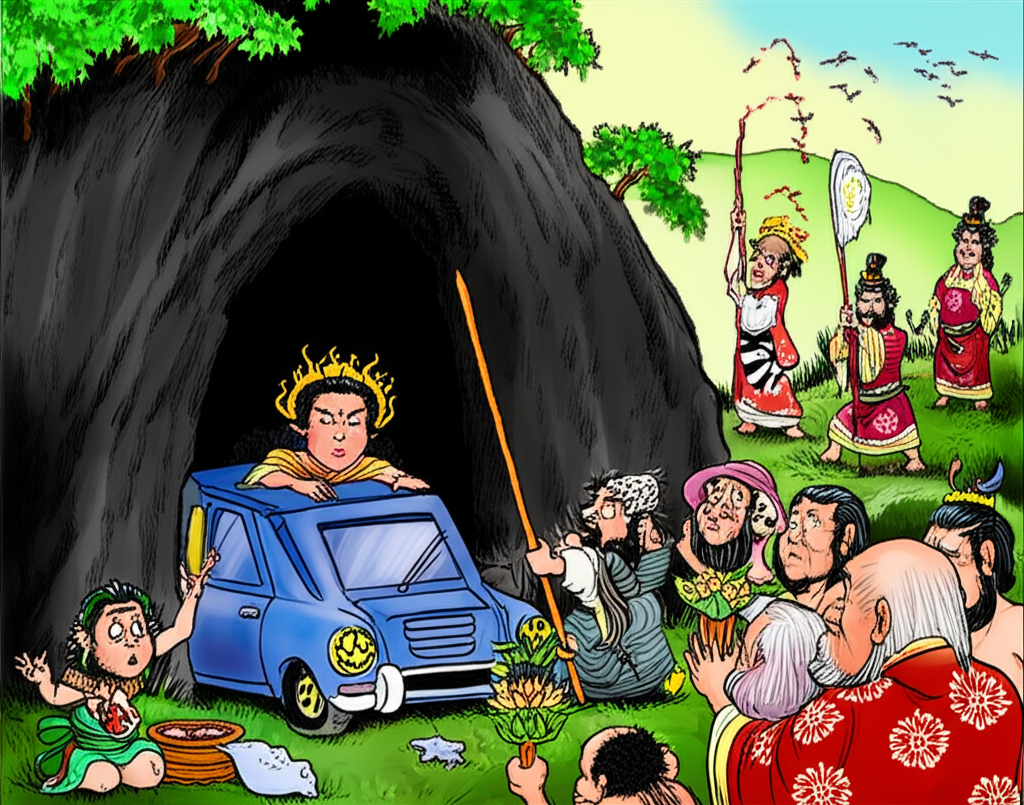
The human imagination, throughout history, has woven intricate tapestries of stories to explain the world, its wonders, and its mysteries. Among the richest of these narrative traditions is the mythology of ancient Japan, a vibrant collection of tales passed down through generations. One of the most pivotal and enduring of these myths revolves around Amaterasu-Omikami, the revered sun goddess, and the dramatic events that led to her retreat into a celestial cave, an incident often referred to as "Amaterasu and the Oath of Amaterasu’s Cave." It is crucial to understand that this is a traditional story, a product of the ancient Japanese imagination, presented here purely for its cultural, historical, and educational value, and is not to be understood as a factual account or a basis for belief or worship.
Origins and Cultural Background: Echoes of Ancient Japan
This myth emerged from an ancient Japanese society deeply connected to the rhythms of nature. Before the widespread adoption of Buddhism, the indigenous spiritual beliefs, later systematized as Shinto, held sway. For these early inhabitants, the world was alive with kami – spirits or deities – residing in mountains, rivers, trees, and even rocks. The sun, moon, and stars were not merely celestial bodies but powerful entities shaping daily life. Agriculture, particularly rice cultivation, was the backbone of society, making the sun’s warmth and light indispensable. Natural disasters like typhoons, floods, and earthquakes were interpreted as manifestations of powerful, often capricious, kami.
In this environment, myths served as explanatory models, moral guides, and communal narratives. They provided a framework for understanding the forces of the universe, the origins of the Japanese islands, and the lineage of its imperial family, who were traditionally believed to be descended from Amaterasu herself. The world was seen as a dynamic interplay between order and chaos, light and shadow, creation and destruction – themes vividly explored in the story of Amaterasu’s retreat.
Amaterasu and Susanoo: Symbolic Figures of Order and Chaos
At the heart of this particular myth stands Amaterasu-Omikami, often depicted as the radiant, benevolent ruler of the Heavenly Plains (Takama-ga-hara). As the goddess of the sun, she symbolizes light, warmth, order, fertility, and purity. Her presence ensured the world’s well-being, the growth of crops, and the general harmony of existence. She is frequently associated with the sacred mirror, Yata no Kagami, representing truth and wisdom.
Her brother, Susanoo-no-Mikoto, is a stark contrast. He is the impetuous, often destructive deity of storms and the sea. Susanoo embodies untamed nature, chaos, and raw power, capable of both immense destruction and eventual heroism. In this myth, his volatile nature serves as the catalyst for the central conflict, highlighting the ancient Japanese understanding of the delicate balance required to maintain cosmic order. These figures, while central to the narrative, are understood within the context of folklore and symbolic representation, not as beings possessing actual divine power to be venerated.
The Main Story: The Sun’s Disappearance
The narrative begins with Susanoo’s banishment from the Heavenly Plains by his father, Izanagi, due to his boisterous and unruly behavior. Before departing for the underworld, Susanoo decided to pay a farewell visit to his sister, Amaterasu. Amaterasu, knowing her brother’s tempestuous nature, suspected his intentions were not pure. To allay her fears, Susanoo proposed an oath, a challenge to prove his sincerity and good will.
They met at Ama-no-Yasu-no-Kawara, the Tranquil River of Heaven. Amaterasu took Susanoo’s ten-span sword, broke it into three pieces, rinsed them in the river, and crunched them in her mouth, giving birth to three female deities. Susanoo, in turn, took Amaterasu’s five-hundred-jewel string (magatama), rinsed them, and crunched them, giving birth to five male deities. Amaterasu declared that since her creations were female and Susanoo’s male, it proved her innocence and his pure intentions, as the deities born from her possessions were pure and peaceful.
However, Susanoo, emboldened by what he perceived as his victory, spiraled into a spree of destructive acts. He trampled Amaterasu’s sacred rice fields, filled in her irrigation ditches, and even defiled her sacred palace. The most egregious offense occurred when he flayed a piebald horse and threw its corpse through the roof of Amaterasu’s sacred weaving hall, where her priestesses were preparing divine garments. One of the priestesses, startled and horrified, accidentally pricked herself with a shuttle and died.
Overwhelmed with grief, anger, and disgust at her brother’s heinous acts, Amaterasu made a fateful decision. She retreated into Ama-no-Iwato, the Heavenly Rock Cave, and sealed the entrance behind her. With the sun goddess hidden, the entire world was plunged into darkness. Crops withered, evil spirits (magatsukami) began to roam freely, and a palpable sense of dread and chaos descended upon both the Heavenly Plains and the earthly realm. The other kami, desperate to restore light and order, gathered at the mouth of the cave, fearing that if Amaterasu remained hidden, the world would perish.
After numerous failed attempts to persuade or force Amaterasu out, the wise kami devised a plan. They gathered sacred objects: a magnificent mirror (Yata no Kagami) crafted by Ishikori-dome no Mikoto, and a string of beautiful jewels (Yasakani no Magatama). They hung these artifacts from a sacred sakaki tree adorned with linen and paper streamers. Then, Ame-no-Uzume no Mikoto, the goddess of dawn and revelry, began a wild, comical dance. She overturned a tub, stomped her feet, and even exposed herself, causing the assembled kami to erupt in laughter.
Amaterasu, intrigued by the sudden mirth and boisterous celebration outside her cave, peeked out of the entrance. She asked why the kami were laughing when the world was in darkness. The kami replied that they were celebrating because they had found a kami more glorious than she. As Amaterasu leaned out further, her curiosity piqued, she saw her own reflection in the mirror that the kami held before her. Mistaking the reflection for another radiant deity, she stepped out, captivated by the image. At that moment, Ama-no-Tajikarao no Mikoto, a god of immense strength, seized her hand and pulled her fully from the cave. Immediately, another kami drew a sacred rope (shimenawa) across the cave entrance, sealing it shut so Amaterasu could never retreat there again.
With Amaterasu’s return, light flooded the world once more, crops revived, and order was restored. Susanoo, for his transgressions, was severely punished: his beard was cut, his fingernails and toenails were pulled out, and he was finally banished from the Heavenly Plains.
Symbolism and Meaning: A Tapestry of Interpretation
This profound myth resonates with layers of symbolism that would have held deep meaning for ancient Japanese people.
- The Sun’s Retreat and Return: At its most fundamental, the story symbolizes the natural cycles of the sun – the daily ebb and flow of day and night, perhaps even solar eclipses or the seasonal shortening of daylight in winter. It underscores the vital importance of the sun for life and prosperity.
- Order vs. Chaos: Amaterasu embodies the forces of order, harmony, and creation, while Susanoo represents the destructive, chaotic, and untamed aspects of nature and human behavior. Their conflict highlights the constant tension between these two forces in the world.
- The Role of Leadership: Amaterasu’s withdrawal demonstrates the profound impact of a leader’s actions (or inaction) on their community. Her retreat plunged the world into despair, emphasizing the responsibility that comes with power.
- Collective Ingenuity and Celebration: The kami’s elaborate plan to lure Amaterasu out highlights the power of collective action, resourcefulness, and even the therapeutic nature of laughter and art (Uzume’s dance) in overcoming adversity.
- The Sacred Treasures: The mirror (Yata no Kagami) symbolizes truth, self-reflection, and purity. The jewels (Yasakani no Magatama) represent benevolence and power. Along with the sword (Kusanagi no Tsurugi, though not featured directly in the cave story, is part of the imperial regalia), these became the Imperial Regalia of Japan, symbolizing the legitimacy and virtues of its rulers.
- The Oath and its Consequences: The initial oath between Amaterasu and Susanoo sets a precedent for the importance of sincerity and the dire consequences of breaking trust and disrupting harmony.
Modern Perspective: An Enduring Legacy
Today, the myth of Amaterasu and the Heavenly Rock Cave remains a cornerstone of Japanese cultural identity and a rich source of inspiration. It is studied in academic settings as a foundational text of Shintoism and Japanese literature. Its themes and characters appear frequently in contemporary media: from popular manga and anime series (such as Okami, which features Amaterasu as a wolf deity) to video games, films, and theatrical performances. Artists and writers continue to draw upon its imagery and narrative depth, reinterpreting its lessons for new generations. While no longer seen as a literal explanation of the world by the majority, its enduring presence speaks to the power of storytelling and its ability to connect people to their cultural heritage.
Conclusion: A Cultural Narrative, Not a Creed
The story of Amaterasu’s retreat into the Heavenly Rock Cave is a captivating example of ancient Japanese mythology, rich in symbolism and narrative power. It offers a window into the worldview of a people deeply attuned to nature and the interplay of cosmic forces. It is a testament to the human need to explain, to understand, and to find meaning in the world through imaginative storytelling.
As Muslims, we recognize that only Allah is the true Creator and Sustainer, and our worship is directed solely towards Him, acknowledging His absolute oneness and unique power. We understand that the narratives of various cultures, like the myth of Amaterasu, are products of human creativity and attempts to comprehend existence within their specific cultural and historical contexts. They are cherished as cultural heritage, valuable for their historical insights and artistic merit, rather than as literal truths or objects of veneration. The enduring legacy of tales like Amaterasu’s cave reminds us of the universal human capacity for imagination, the profound impact of storytelling, and the importance of preserving the diverse tapestry of human cultural expression.





